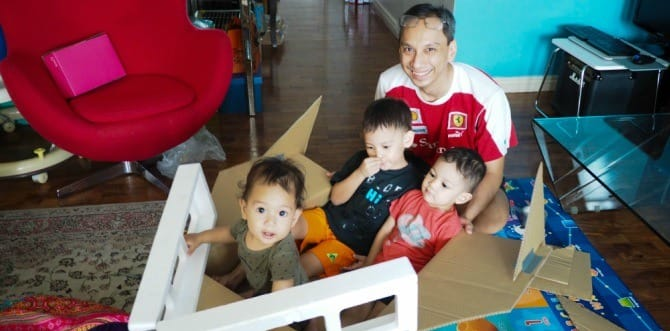Are Your Kids Ready to Go Back to School? Bolster Their Confidence With These 5 Steps to Resilience
by on 12/07/2021 ...

As a parent, you wish you could protect your kids from every disappointment, defeat, or scary challenge.
Although this isn’t possible, you can teach your children to be resilient.
Resilient children have grit. When they encounter a difficult problem, they try to solve it instead of giving up. When bad things happen, they quickly bounce back, ready to face the next challenge. When they make mistakes, they grow and learn from them. Resilient children are hopeful, optimistic, and strong.

Here are 5 simple ways to raise a resilient child:
1. Be a supportive role model.
Instead of complaining that your child doesn’t share, doesn’t clean up. Stop, Pause. Ask yourself when did you demonstrate that behavior?
Your child needs one stable, committed relationship with a supportive adult role model.
The more positive adult connections a child has, the more resilient s/he will be. These relationships can be with grandparents, aunts and uncles, teachers, coaches, or any other positive adult in your child’s life.
Foster and encourage relationships with strong and positive adults, and continue being the supportive role model your child needs.
Your child watches and learns from everything you do, so model resilient behaviors. Be calm and consistent. Admit to your mistakes, but don’t agonize over them. Talk to your child about what you learned or how you can do better next time.
2. Let children make mistakes. Mistakes are proof that your child is learning.
When your daughter does a hurried, poor job on a school project, you may feel a strong urge to help her improve or fix it. Stop!
If you’re busy at work, and your son calls to say he left his homework on the table, you may want to rush to the rescue. Stop!
As uncomfortable as it is to let our children make mistakes, this is one way that kids develop resiliency.
Find humor in mistakes.
“Oopsie…. I made a mistake!”
“I am sorry I made a mistake.”
“I apologise that I forgot to replace the towels.”
if children never make mistakes, they’ll never learn how to fix their errors or make better decisions in the future.
Failure teaches perseverance and problem-solving. It causes children to think about their actions and how to avoid repeating those mistakes in the future.

3. Praise Kids the Right Way
The way we praise our kids can affect their mindset and their inclination to take on challenges and persevere.
“You’re so smart!”, they develop a fixed mindset. With a fixed mindset, children believe that qualities like intelligence are personal characteristics that don’t change or develop. As a result, they may avoid challenges that will test their abilities.
Instead of giving “person praise,” like, “You’re so smart,” or “You’re so creative,” try to give “process praise.” Focus on your child’s effort, as in, “I can tell you’ve been working really hard.” You can also give specific praise, like, “You really understand decimals!”
When a child with a growth mindset makes a mistake, the child focuses on how to improve next time. When a child with a fixed mindset makes a mistake, he’s more likely to believe that failure is the result of personal characteristics, such as, “I can’t spell,” or, “I’m just not good at math.
4. Teach Children to Manage Emotions
Managing emotions is key to developing resilience. Emotional coaching is the key to raising resilient and happy children.
The first step is to teach our children that ALL emotions, even the worst ones, are okay. Negative emotions can be opportunities to learn about ourselves, grow, and learn how to cope with these feelings effectively.
This step also involves helping your child label and validate his emotions. For example, you might say, “I understand you’re feeling angry because Angie wouldn’t let you play with his toys.”
The second step is to deal with bad behavior, if there was any, in order to set limits. For instance, if your child threw a tantrum, he would face consequences at this point. Explain that your child is not in trouble for feeling angry; he’s in trouble for the way he handled his anger.
Finally, you problem-solve. Help your child brainstorm ways to fix the problem or to prevent it from happening again in the future.
I strongly recommend taking ten minutes at bedtime to discuss the day. During this time, you can repair moments of conflict or misunderstanding. Help your child put the day’s disappointments and perceived failures in perspective.
Ask your child if there’s anything he wants to talk about, and LISTEN patiently to his feelings. If there has been conflict between you and your child, try to set aside your feelings and listen to his side of the story, then talk through it and work together to resolve the disagreement.
As children learn to manage emotions in a healthy way, they will also learn to be more resilient. They will be able to deal with life’s challenges and disappointments with emotional maturity instead of tantrums, breakdowns, and giving up.

5. Teach Kids to Problem-Solve
When your child comes to you with a problem, help her brainstorm ways to address the challenge. For example, if your child is nervous about a test, talk through specific solutions like developing a study schedule, finding effective study strategies, and managing time.
As you brainstorm, help your child consider what the results might be for each solution she proposes.
We should give our children frequent opportunities to learn WHAT works and what doesn’t. This means that we shouldn’t immediately rush to solve problems for our children or tell them the best solution. Trial and error is one of the best ways for our children to learn. This, too, is uncomfortable but necessary.
Children who know how to tackle challenges head-on will grow to be resilient. These children can take failures and disappointment in stride, knowing that these are only problems to be solved.
Step 1: What is the problem I am facing?
Step 2: Different ways I can solve my problem.
Step 3: What would happen (Step 2)?
Step 4: Discuss tried Step 2s.
Being positive does not mean ignoring the problem and being happy. Being positive means to be resilient and find a workaround to carry on with life. Not letting anything or anyone stop you!
This article was written by Nandhini Sivanna from Brainbow Kids. Brainbow Kids supports children with emotional intelligence tools via creative art. They also offer subscription-based craft boxes. Subscribe today!

































